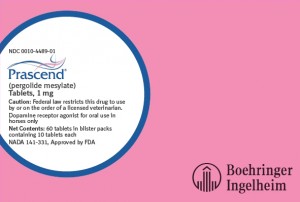
For the first time, the Food and Drug Administration has approved a medication to control signs of equine Cushing’s disease, also known as pituitary pars intermedia dysfunction, or PPID. The drug is Prascend (pergolide mesylate), from Boehringer Ingelheim Vetmedica. Although pergolide in various forms has been used for years to help manage signs of PPID, FDA approval is welcome news for owners of horses with this condition.
PPID strikes many older horses, most 15 or older but some younger. It affects the pituitary gland, a master gland that orchestrates the production of the hormones that regulate body functions. The disease has no cure and causes a host of problems, some of which can be life threatening. They include abnormal hair growth, sweating and fat distribution; weight loss, muscle wasting and lethargy; excessive drinking and urination; chronic infections; and laminitis.
Horses with PPID are thought to have reduced levels of a body chemical, the neurotransmitter dopamine, which acts on the pituitary gland. Pergolide stimulates dopamine production, and many horses improve on daily doses. The drug was used until 2007 to manage the signs and symptoms of Parkinson’s disease in humans; and, while it wasn’t labeled for use in horses, veterinarians could prescribe it “extralabel.” But then pergolide was pulled off the market because it increased risks of heart problems in human patients, and US drug companies stopped making it.
For almost five years the medication has been available only as a custom order from veterinary compounding pharmacies, which make up medications from bulk ingredients. Prascend, which is sold in tablet form by prescription, should be more widely available than pergolide. The FDA approval means that the product has been evaluated for safety and efficacy and that it meets standards for strength, quality, purity, consistency from batch to batch and stability over time.
This article originally appeared in the February 2012 issue of Practical Horseman magazine.










